RENAULT KANGOO VAN ZERO EMISSION 2012 X61 / 2.G Owner's Guide
Manufacturer: RENAULT, Model Year: 2012, Model line: KANGOO VAN ZERO EMISSION, Model: RENAULT KANGOO VAN ZERO EMISSION 2012 X61 / 2.GPages: 220, PDF Size: 4.52 MB
Page 31 of 220
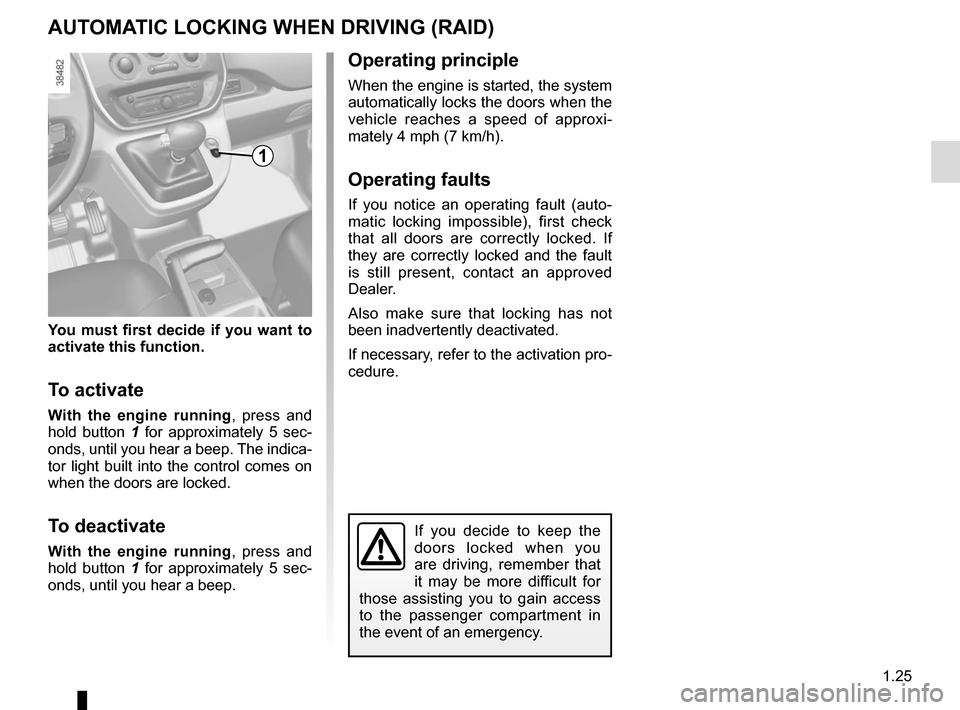
1.25
You must first decide if you want to
activate this function.
To activate
With the engine running, press and
hold button 1 for approximately 5 sec-
onds, until you hear a beep. The indica-
tor light built into the control comes on
when the doors are locked.
To deactivate
With the engine running , press and
hold button 1 for approximately 5 sec-
onds, until you hear a beep.
If you decide to keep the
doors locked when you
are driving, remember that
it may be more difficult for
those assisting you to gain access
to the passenger compartment in
the event of an emergency.
AUTOMATIC LOCKING WHEN DRIVING (RAID)
Operating principle
When the engine is started, the system
automatically locks the doors when the
vehicle reaches a speed of approxi-
mately 4 mph (7 km/h).
Operating faults
If you notice an operating fault (auto-
matic locking impossible), first check
that all doors are correctly locked. If
they are correctly locked and the fault
is still present, contact an approved
Dealer.
Also make sure that locking has not
been inadvertently deactivated.
If necessary, refer to the activation pro-
cedure.
1
Page 32 of 220
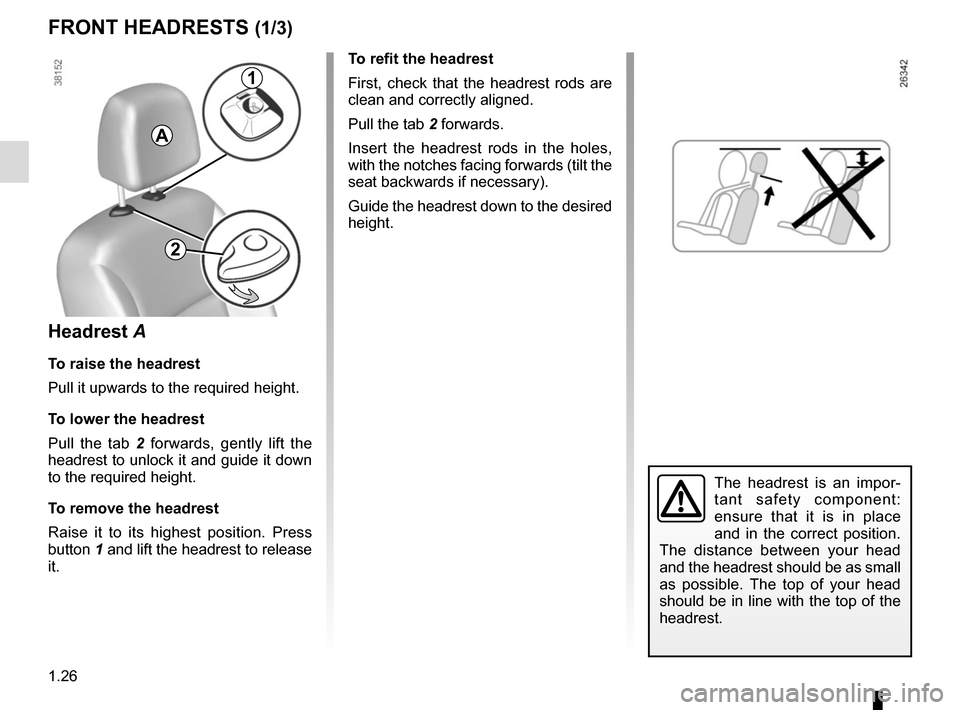
1.26
FRONT HEADRESTS (1/3)
To refit the headrest
First, check that the headrest rods are
clean and correctly aligned.
Pull the tab 2 forwards.
Insert the headrest rods in the holes,
with the notches facing forwards (tilt the
seat backwards if necessary).
Guide the headrest down to the desired
height.
Headrest A
To raise the headrest
Pull it upwards to the required height.
To lower the headrest
Pull the tab 2 forwards, gently lift the
headrest to unlock it and guide it down
to the required height.
To remove the headrest
Raise it to its highest position. Press
button 1 and lift the headrest to release
it.
A
The headrest is an impor-
tant safety component:
ensure that it is in place
and in the correct position.
The distance between your head
and the headrest should be as small
as possible. The top of your head
should be in line with the top of the
headrest.
1
2
Page 33 of 220
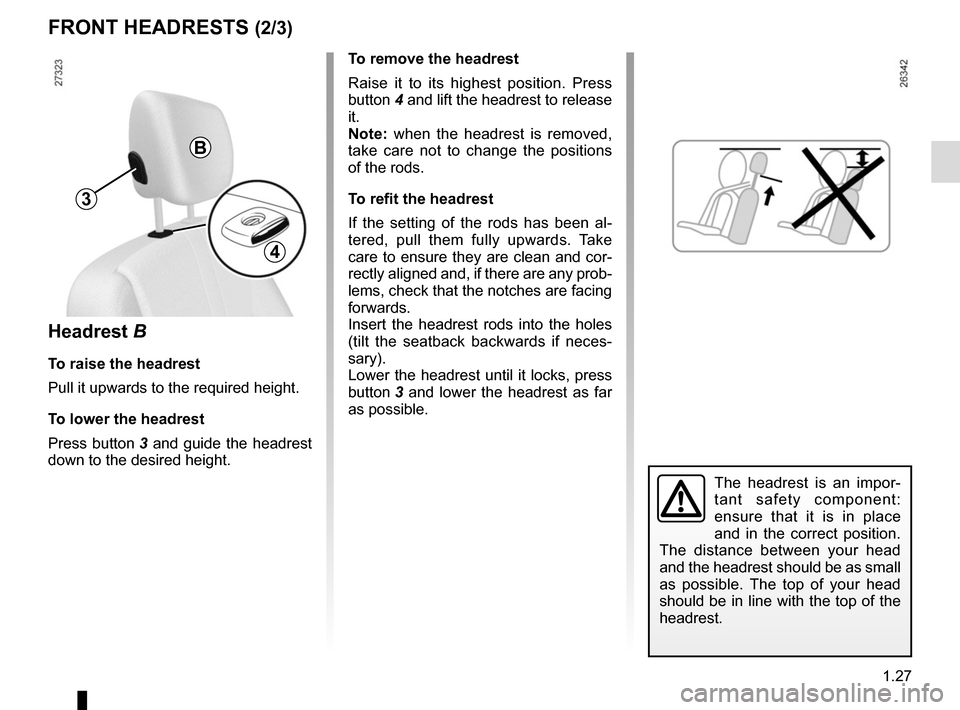
1.27
To remove the headrest
Raise it to its highest position. Press
button 4 and lift the headrest to release
it.
Note: when the headrest is removed,
take care not to change the positions
of the rods.
To refit the headrest
If the setting of the rods has been al-
tered, pull them fully upwards. Take
care to ensure they are clean and cor-
rectly aligned and, if there are any prob-
lems, check that the notches are facing
forwards.
Insert the headrest rods into the holes
(tilt the seatback backwards if neces-
sary).
Lower the headrest until it locks, press
button 3 and lower the headrest as far
as possible.
FRONT HEADRESTS (2/3)
Headrest B
To raise the headrest
Pull it upwards to the required height.
To lower the headrest
Press button 3 and guide the headrest
down to the desired height.
The headrest is an impor-
tant safety component:
ensure that it is in place
and in the correct position.
The distance between your head
and the headrest should be as small
as possible. The top of your head
should be in line with the top of the
headrest.
3
B
4
Page 34 of 220
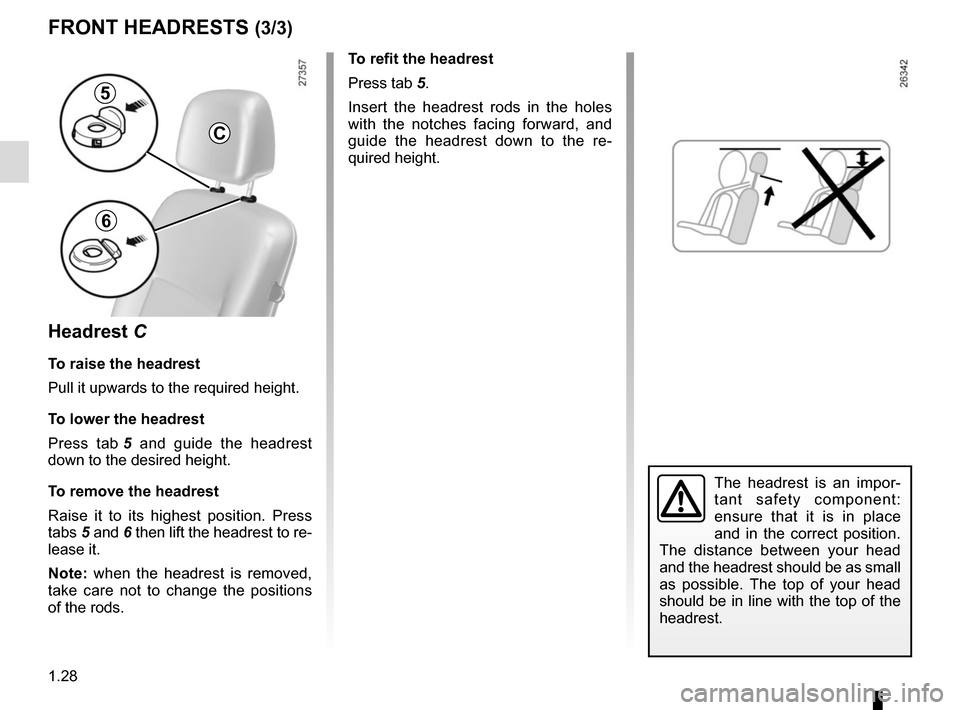
1.28
FRONT HEADRESTS (3/3)
Headrest C
To raise the headrest
Pull it upwards to the required height.
To lower the headrest
Press tab 5 and guide the headrest
down to the desired height.
To remove the headrest
Raise it to its highest position. Press
tabs 5 and 6 then lift the headrest to re-
lease it.
Note: when the headrest is removed,
take care not to change the positions
of the rods.
To refit the headrest
Press tab 5.
Insert the headrest rods in the holes
with the notches facing forward, and
guide the headrest down to the re-
quired height.
The headrest is an impor-
tant safety component:
ensure that it is in place
and in the correct position.
The distance between your head
and the headrest should be as small
as possible. The top of your head
should be in line with the top of the
headrest.
5
6
C
Page 35 of 220
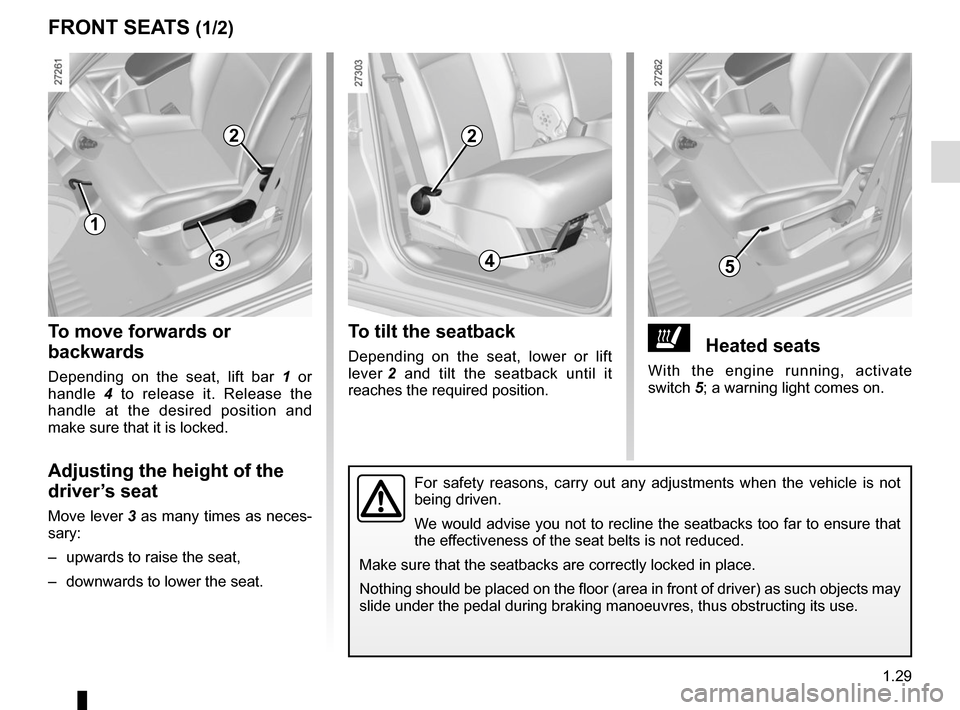
1.29
FRONT SEATS (1/2)
1
2
534
2
ðHeated seats
With the engine running, activate
switch 5; a warning light comes on.
To tilt the seatback
Depending on the seat, lower or lift
lever 2 and tilt the seatback until it
reaches the required position.
To move forwards or
backwards
Depending on the seat, lift bar 1 or
handle 4 to release it. Release the
handle at the desired position and
make sure that it is locked.
Adjusting the height of the
driver’s seat
Move lever 3 as many times as neces-
sary:
– upwards to raise the seat,
– downwards to lower the seat.
For safety reasons, carry out any adjustments when the vehicle is not
being driven.
We would advise you not to recline the seatbacks too far to ensure that
the effectiveness of the seat belts is not reduced.
Make sure that the seatbacks are correctly locked in place.
Nothing should be placed on the floor (area in front of driver) as suc\
h objects may
slide under the pedal during braking manoeuvres, thus obstructing its us\
e.
Page 36 of 220
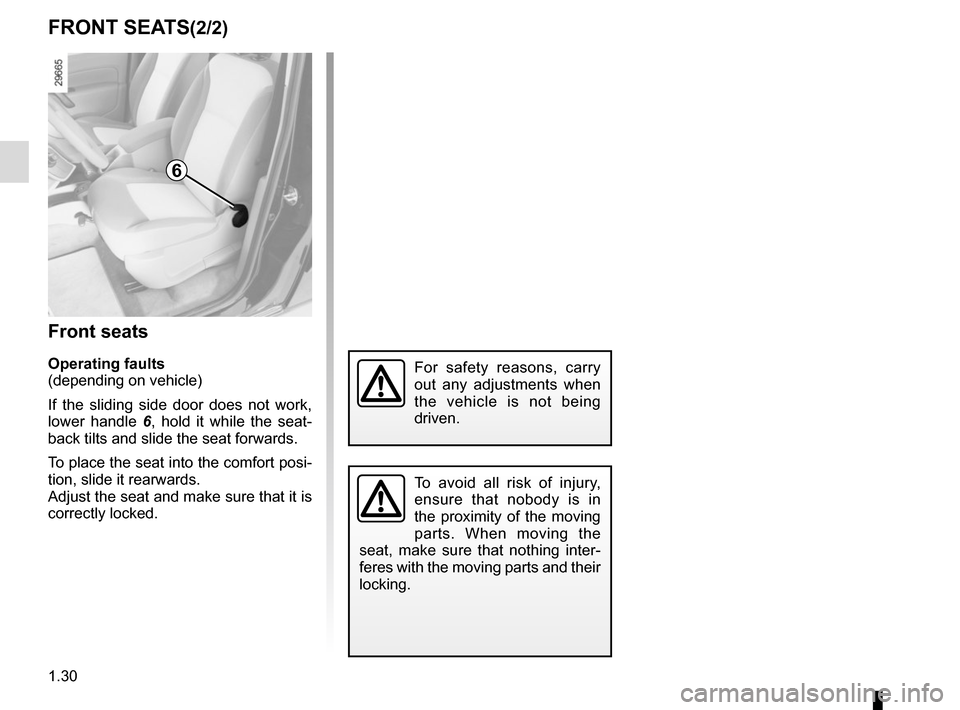
1.30
FRONT SEATS(2/2)
Front seats
Operating faults
(depending on vehicle)
If the sliding side door does not work,
lower handle 6, hold it while the seat-
back tilts and slide the seat forwards.
To place the seat into the comfort posi-
tion, slide it rearwards.
Adjust the seat and make sure that it is
correctly locked.
To avoid all risk of injury,
ensure that nobody is in
the proximity of the moving
parts. When moving the
seat, make sure that nothing inter-
feres with the moving parts and their
locking.
For safety reasons, carry
out any adjustments when
the vehicle is not being
driven.
6
Page 37 of 220

1.31
ROOF FLAP (1/2)
Driving with the roof flap
open may be unpleasant
for passengers because
exhaust gas may enter the
passenger compartment. This use
is solely for short distances, or for
transporting bulky objects with-
out having to open the rear doors. In
this case, close the other windows
and operate the ventilation system
at the half or fully open setting ,
as this will help to prevent exhaust
fumes from entering the passenger
compartment.
123
Transverse bar
When loading bulky objects, the trans-
verse bar may be moved:
– Press the handle 3;
– lift the bar all the way to the door pillar;
– lock the bar after loading.
To open:
– Unlock the control 2, the roof flap lifts
automatically (make sure that noth-
ing prevents the flap from opening.
In this case, use the handle 1 to help
raise it);
– when the roof flap is open, it must be locked by pushing it towards the
front of the vehicle until the control 2
locks.
Important: It is prohibited to drive with
the roof flap open and unlocked. Note: When driving with the roof flap
open, you may hear wind noise. To
reduce these, open one of the side win-
dows slightly.
Page 38 of 220
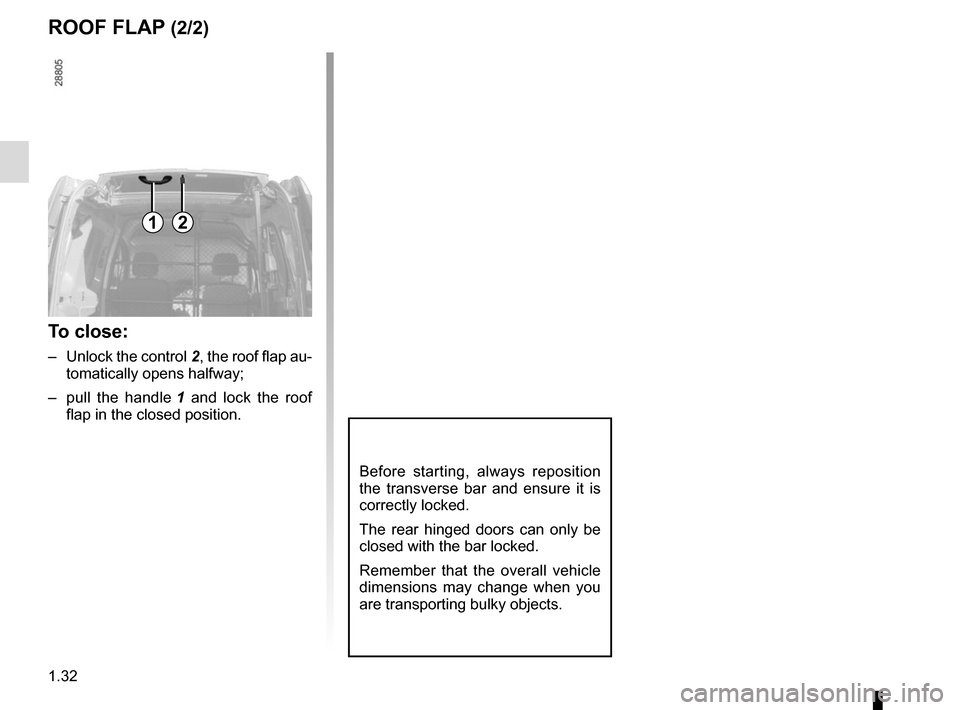
1.32
ROOF FLAP (2/2)
Before starting, always reposition
the transverse bar and ensure it is
correctly locked.
The rear hinged doors can only be
closed with the bar locked.
Remember that the overall vehicle
dimensions may change when you
are transporting bulky objects.
12
To close:
– Unlock the control 2, the roof flap au-
tomatically opens halfway;
– pull the handle 1 and lock the roof
flap in the closed position.
Page 39 of 220
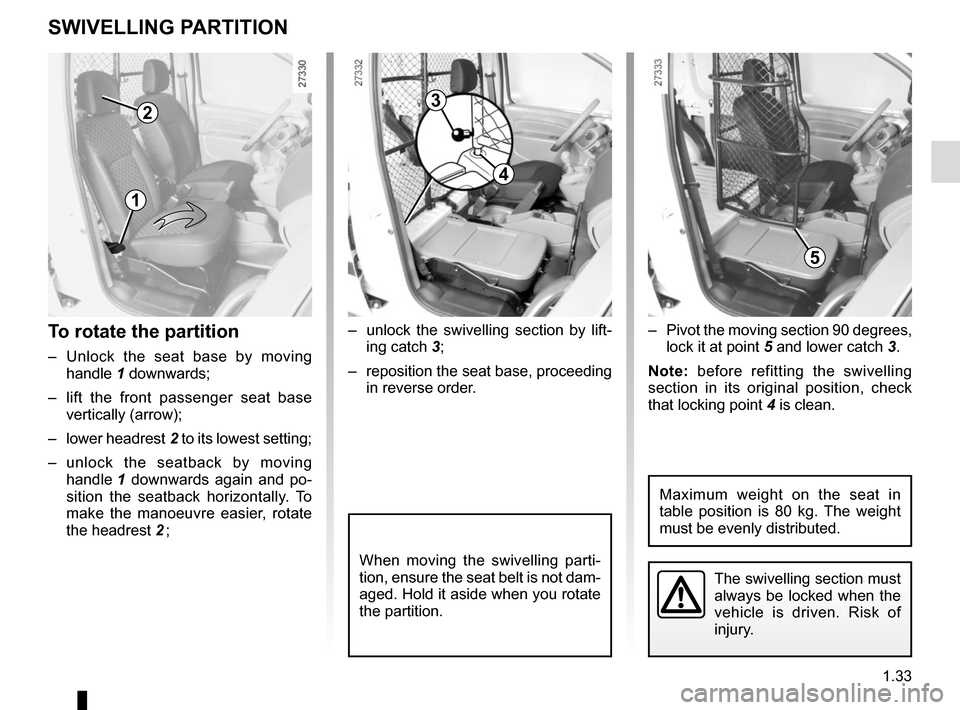
1.33
To rotate the partition
– Unlock the seat base by moving handle 1 downwards;
– lift the front passenger seat base vertically (arrow);
– lower headrest 2 to its lowest setting;
– unlock the seatback by moving handle 1 downwards again and po-
sition the seatback horizontally. To
make the manoeuvre easier, rotate
the headrest 2 ; – Pivot the moving section 90 degrees,
lock it at point 5 and lower catch 3.
Note: before refitting the swivelling
section in its original position, check
that locking point 4 is clean.
– unlock the swivelling section by lift-
ing catch 3;
– reposition the seat base, proceeding in reverse order.
The swivelling section must
always be locked when the
vehicle is driven. Risk of
injury.
SWIVELLING PARTITION
When moving the swivelling parti-
tion, ensure the seat belt is not dam-
aged. Hold it aside when you rotate
the partition.
1
23
4
5
Maximum weight on the seat in
table position is 80 kg. The weight
must be evenly distributed.
Page 40 of 220
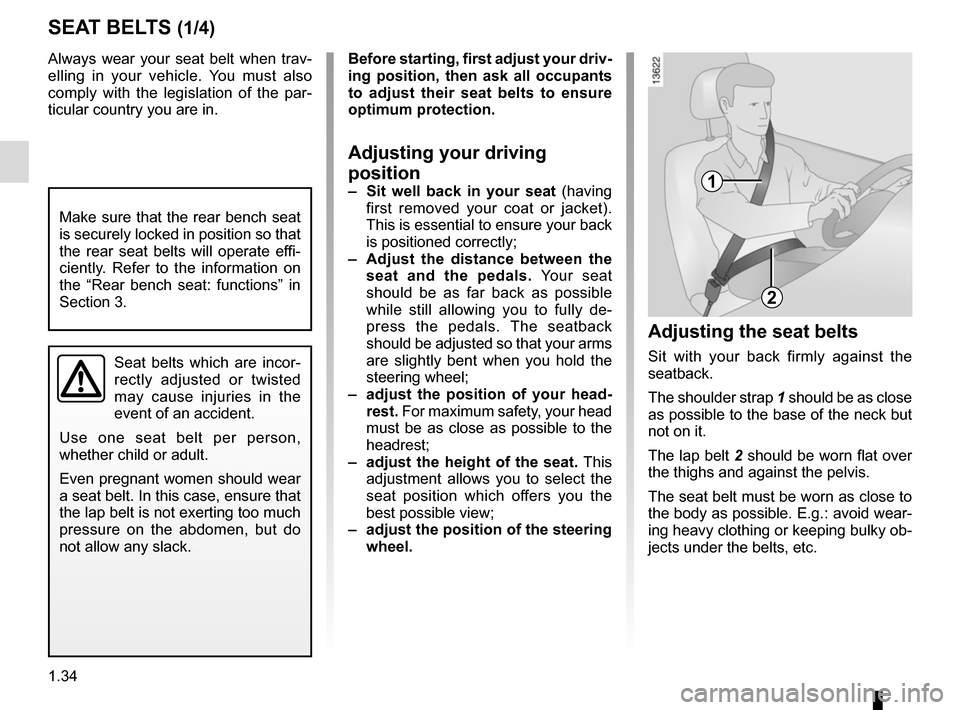
1.34
SEAT BELTS (1/4)Adjusting the seat belts
Sit with your back firmly against the
seatback.
The shoulder strap 1 should be as close
as possible to the base of the neck but
not on it.
The lap belt 2 should be worn flat over
the thighs and against the pelvis.
The seat belt must be worn as close to
the body as possible. E.g.: avoid wear-
ing heavy clothing or keeping bulky ob-
jects under the belts, etc.
1
2
Always wear your seat belt when trav-
elling in your vehicle. You must also
comply with the legislation of the par-
ticular country you are in.
Seat belts which are incor-
rectly adjusted or twisted
may cause injuries in the
event of an accident.
Use one seat belt per person,
whether child or adult.
Even pregnant women should wear
a seat belt. In this case, ensure that
the lap belt is not exerting too much
pressure on the abdomen, but do
not allow any slack.
Before starting, first adjust your driv-
ing position, then ask all occupants
to adjust their seat belts to ensure
optimum protection.
Adjusting your driving
position
– Sit well back in your seat (having
first removed your coat or jacket).
This is essential to ensure your back
is positioned correctly;
– Adjust the distance between the seat and the pedals. Your seat
should be as far back as possible
while still allowing you to fully de-
press the pedals. The seatback
should be adjusted so that your arms
are slightly bent when you hold the
steering wheel;
– adjust the position of your head- rest. For maximum safety, your head
must be as close as possible to the
headrest;
– adjust the height of the seat. This
adjustment allows you to select the
seat position which offers you the
best possible view;
– adjust the position of the steering
wheel.
Make sure that the rear bench seat
is securely locked in position so that
the rear seat belts will operate effi-
ciently. Refer to the information on
the “Rear bench seat: functions” in
Section 3.